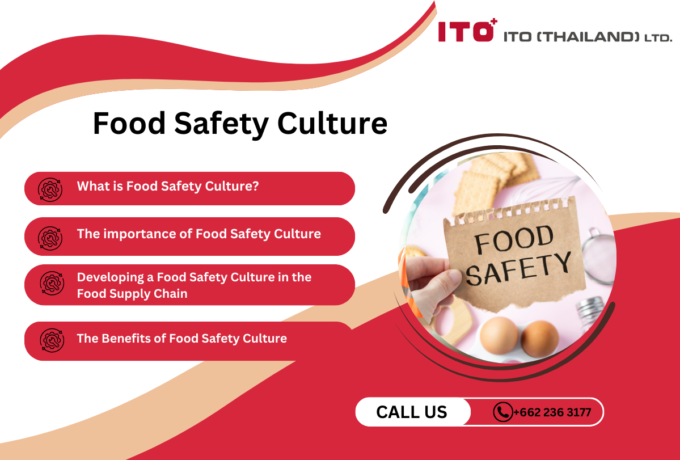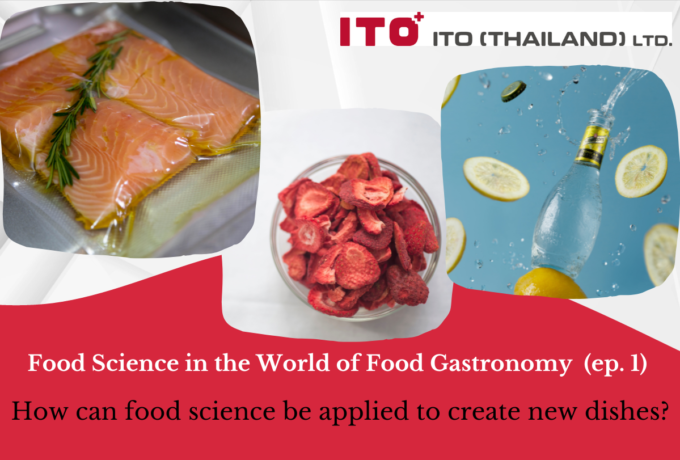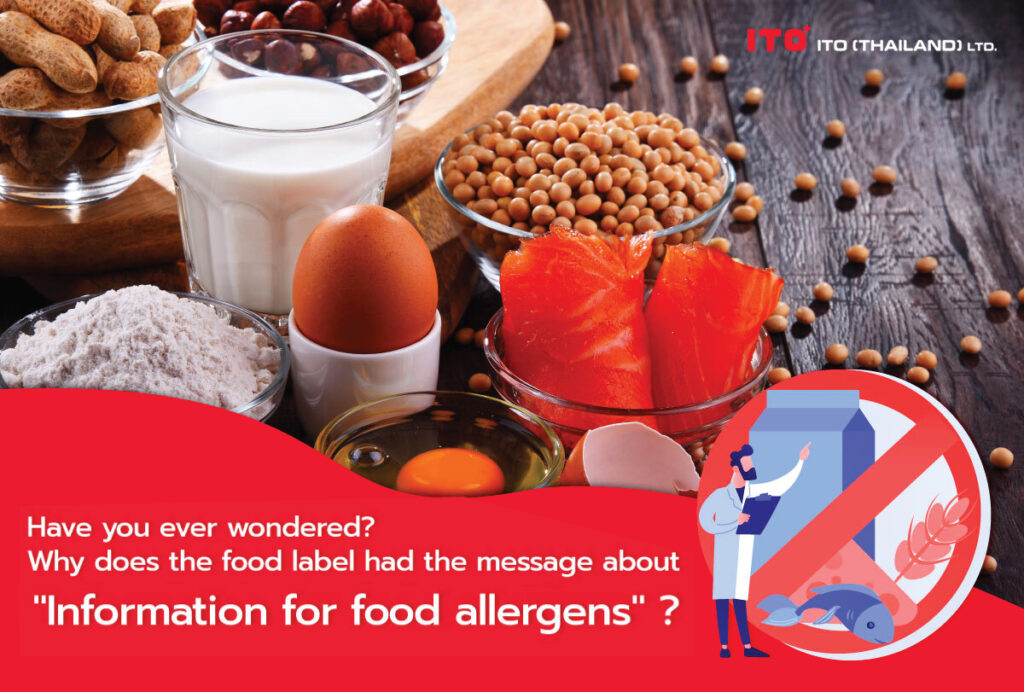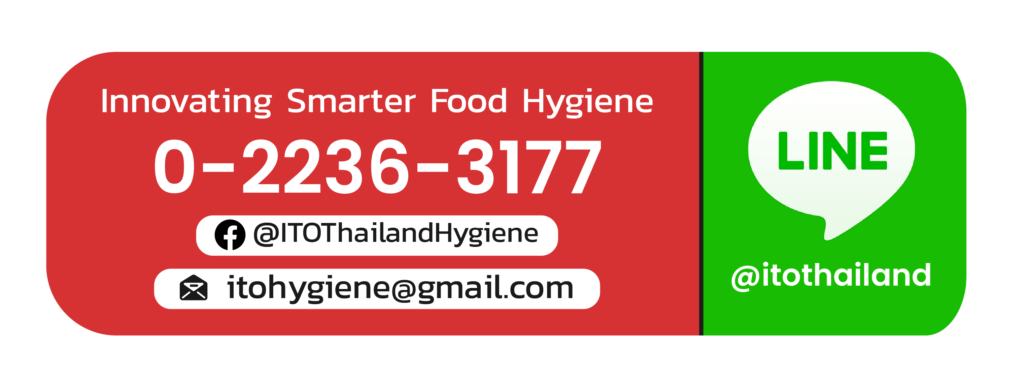ITO Thailand Hygiene Blog
Allergens
Food ingredients that are required to be displayed on the label in this manner are foods that contain allergens which are considered as a group of proteins causing allergic reactions or illnesses to some consumers after ingestion such as shortness of breath, swollen airway, swollen mouth, itchy rash and death for a very severe case depending on the nature of immune system or antibody of that particular person while the consumers who are not sensitive to these allergens can eat normally.
For the safety of people with allergies, food legislation of each country requires food manufacturers to display these potentially allergenic ingredients on their labels so that the consumers can choose or avoid foods that cause allergies or turn to choose non- allergenic alternative protein consumption; for example, those who are allergic to cow’s milk can drink plant-based milk instead. However, the legislation of each country will enforce to indicate different groups of allergens due to different factors such as the genetics of the majority of population, popular consumer products, geographical and cultural characteristics, etc. The entrepreneurs, therefore, must consider the legislation of the destination country as the basis for providing information on allergens.
In Thailand, the legislation on allergen labeling had been prescribed by the Food and Drug Administration, Ministry of Public Health according to Notification of the Ministry of Public Health (No. 383) B.E. 2560 (2017) regarding Labelling of Pre-packaged Foods stating that allergens required to be displayed on the label are:
1.Grains that contain gluten include wheat, rye, barley, oat, spelt or hybrid grains and products from these grains, except for glucose syrup from wheat and barley, maltodextrin from wheat and alcohol resulted from the distillation of grains
2.Crustaceans such as shrimps, crabs, mantis shrimps, lobsters and products from these crustaceans
3.Eggs and egg products
4.Fish and fish products, except fish gelatin which is used as a carrier of vitamins and carotenoids
5.Peanuts and peanut products
6.Soybeans and soybean products, except some types such as refined soybean oil/soy fat, tocopherols, phytosterols and stanol esters from soybeans, etc.
7.Milk and dairy products, except lactitol
8.Nuts (e.g., walnut, almond, pecan) and their products
9.Sulfites level is more than or equal to 10 mg/kg
Specifying information on the label is subject to the nature of the presence of allergens in the product.
– In case the food product contains any of these, it is required to specify “Information for food allergy: Contains…”.
– In case the food product is contaminated in production process, it is required to specify “Information for food
allergy: May contain…”
For allergen management in the plant, some management examples are recommended as follows:
1.Assessment of raw materials to identify the presence and potential opportunities of allergen contamination
2.Assessment of potential points of contamination throughout the process
3.Assessment of the finished products
4.Assessment of cross-contamination risks
5.Establishment of control measures to mitigate or eliminate risks
6.Establishment of work procedures when required to reproduce or revise
7.Design of proper, efficient and no cross-contamination cleaning; for example, use of color coding at cleaning equipment, color coding at cooking utensils or disposal equipment, etc.
8.Design of raw material storage and products with and without allergens to prevent cross-contamination
9.Paying attention to allergens that may float in the air or cling to workers’ uniforms or Shoes
10.Production schedule improvement to distinguish between allergenic products and non-allergenic products
11.Communication with workers to understand the importance of allergens
12.Regular implementation of random check and measure revision
ITO would like to be a part of promoting the food safety society in Thailand in order for Thai food industry to grow sustainably.
Please click here to know more about us.
References:
1.Notification of the Ministry of Public Health (No. 383) B.E. 2560 (2017) regarding Labelling of Pre-packaged Foods
2.CODE OF PRACTICE ON FOOD ALLERGEN MANAGEMENT FOR FOOD BUSINESS OPERATORS (CXC 80-2020) online: https://www.fao.org/fao-who-codexalimentarius/sh-proxy/en/?lnk=1&url=https%253A%252F%252Fworkspace.fao.org%252Fsites%252Fcodex%252FStandards%252FCXC%2B80-2020%252FCXC_080e.pdf
Related Post
-

Food Safety Culture
Food safety culture plays a crucial role in safeguarding the company's reputation, ensuring the well-being of its employees, and providing a safe experience for its customers.
-

New food source safety issues
What are safety issues worth knowing for trendy new food sources like plant-based and insect-based proteins?
-

British Retail Consortium (BRC) Standard
Food safety management systems play a vital role in ensuring the production and distribution of safe and high-quality food products to consumers. With the global food supply chain becoming increasingly complex, food businesses must implement effective systems prioritising safety, quality, and compliance with industry standards. A food safety management system encompasses a set of procedures, processes, and controls designed to identify, prevent, and manage potential hazards at every stage of the food production and supply process. This proactive approach not only safeguards consumers' health but also protects the reputation and credibility of food companies in an ever more competitive market.
-

Food Science in the World of Food Gastronomy (Part 1)
How can food science be applied to create new dishes?
-

FSSC 22000
Food manufacturers must ensure food safety standards and processes. FSSC 22000 is an official certification program for Food Safety Management Systems (FSMS) recognised by the Global Food Safety Initiative (GFSI). This certification scheme offers a set of guidelines and procedures to ensure uniformity, openness, and safety across your entire supply chain. It applies to all companies operating within the food and beverage industry, ranging from farmers to retailers. By fulfilling the necessary criteria and obtaining FSSC 22000 certification, it is demonstrated that the required standards for food quality and implementing effective processes to manage and mitigate risks associated with food fraud, foodborne illnesses, expensive recalls, and other external threats are met.
-

Food Safety Aspects of Artificial Sweeteners
Artificial sweeteners, also known as sugar substitutes, non-nutritive sweeteners, or high-intensity sweeteners, are artificially produced compounds utilised in place of sucrose (table sugar) to add sweetness to food and drinks. Due to their significantly higher sweetness than regular sugar, only a fraction of artificial sweeteners (200 to 20,000 times less) is required to achieve an equivalent level of sweetness. Since the caloric contribution of these sweeteners, when used in such small quantities, is insignificant, they are often referred to as non-nutritive (4).










